ignition SUZUKI RENO 2008 1.G Owners Manual
[x] Cancel search | Manufacturer: SUZUKI, Model Year: 2008, Model line: RENO, Model: SUZUKI RENO 2008 1.GPages: 226, PDF Size: 4.98 MB
Page 9 of 226

0-2
85Z14-03E
IMPORTANT
WARNING/CAUTION/NOTE
Please read this manual and follow its
instructions carefully. To emphasize spe-
cial information, the symbol and the
words WARNING, CAUTION and NOTE
have special meanings. Pay special atten-
tion to the messages highlighted by these
signal words:
NOTE:
Indicates special infor mation to make
maintenance easier or instructions clearer.
75F135
The circle with a slash in this manual
means “Don’t do this” or “Don’t let this hap-
pen”.
MODIFICATION WARNING
WARNING
Indicates a potential hazard that
could result in death or injury.
CAUTION
Indicates a potential hazard that
could result in vehicle damage.
WARNING
Do not modify this vehicle. Modifica-
tion could adversely affect safety,
handling, performance or durability
and may violate governmental regula-
tions. In addition, damage or perfor-
mance problems resulting from
modification may not be covered
under warranty.
CAUTION
Improper installation of mobile com-
munication equipment such as cellu-
lar telephones or CB (Citizen’s Band)
radios may cause electronic interfer-
ence with your vehicle’s ignition sys-
tem, resulting in vehicle performance
problems. Consult your SUZUKI
dealer or qualified service technician
for advice on installing such mobile
communication equipment.
Page 26 of 226

1-14
SEATS AND RESTRAINT SYSTEMS
85Z14-03E
impacts, side impacts, rollovers or minor
frontal collisions. The pretensioners can be
activated only once. If the pretensioners
are activated, have the pretensioner sys-
tem serviced by an authorized SUZUKI
dealer as soon as possible.
If the air bag readiness light on the instru-
ment cluster does not blink or come on
briefly when the ignition switch is turned to
the “ON” position, stays on for more than
10 seconds, or comes on while driving, the
pretensioner system or the air bag system
may not work properly. Have both systems
inspected by an authorized SUZUKI dealer
as soon as possible.
Service on or around the pretensioner sys-
tem components or wiring must be per-
formed only by an authorized SUZUKI
dealer who is specially trained. Improper
service could result in unintended activa-
tion of pretensioners or could render the
pretensioners inoperative. Either of these
two conditions may result in personal
injury.
To prevent damage or unintended activa-
tion of the pretensioners, be sure the bat-
tery is disconnected and the ignition switch
has been in the “LOCK” position for at least
60 seconds before performing any electri-
cal service work on your SUZUKI. Do not
touch pretensioner system components or
wiring. The wires are wrapped with yellow
tape or yellow tubing, and the couplers are
yellow. When scrapping your SUZUKI, askyour SUZUKI dealer, body repair shop or
scrap yard for assistance.
Safety Belt Extender
65D613
(1) Center of body
(2) Less than 152 mm (6 inches)
(3) Open end of extender buckle
If a safety belt cannot be fastened securely
because it is not long enough, see your
authorized SUZUKI dealer for a safety belt
extender. Safety belt extenders are avail-
able for each seating position except for
the rear center position. After inspecting
the relationship between the safety belt
length, the occupant’s body size, and the
seat adjustment (the driver’s seat should
always be adjusted as far back as possible
while still maintaining control of the vehicle,
and other adjustable seats should be
adjusted as far back as possible), yourSUZUKI dealer can select the appropriate
safety belt extender.
A safety belt extender should only be
used for the person, vehicle and seating
location it was provided for.
When using the extender, ensure that
both ends are latched securely. Do not
use the extender if the open end of the
extender’s buckle is within 152 mm (6
inches) of the center of the occupant’s
body (See diagram). Use of the extender
when the buckle is too close to the cen-
ter of the body could increase the risk of
abdominal injury in the event of an acci-
dent, and could cause the shoulder belt
to be positioned incorrectly.
Make sure to use the correct buckle cor-
responding to your seating position.
Safety belt extenders are not intended
for use by pregnant women, and should
only be used upon approval by their
medical advisors.
Remove and stow the extender when it
is not being used.
Safety Belts:
Page 42 of 226
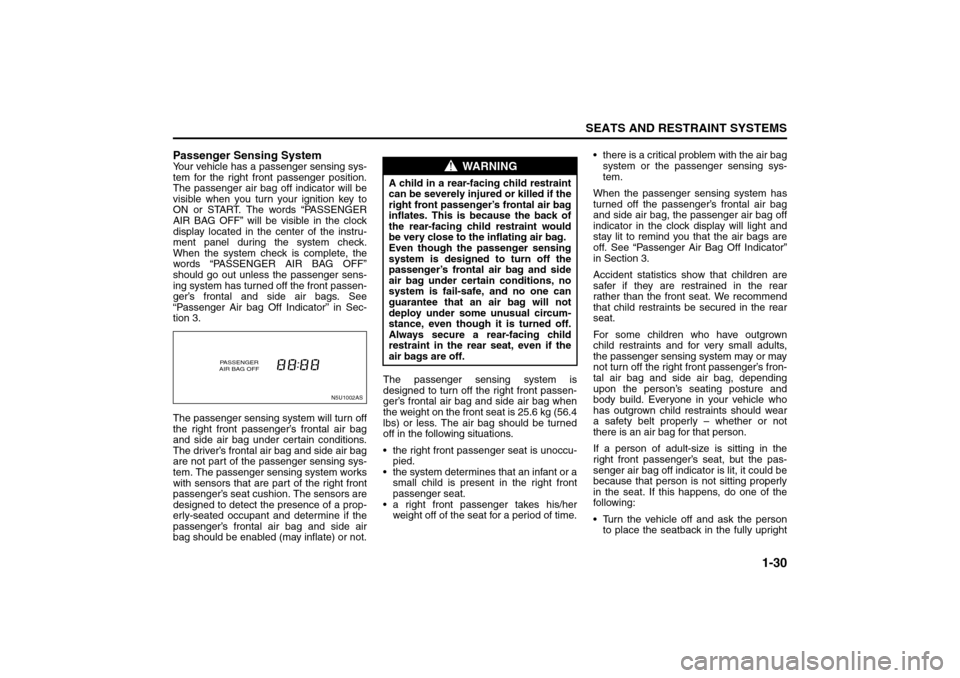
1-30
SEATS AND RESTRAINT SYSTEMS
85Z14-03E
Passenger Sensing SystemYour vehicle has a passenger sensing sys-
tem for the right front passenger position.
The passenger air bag off indicator will be
visible when you turn your ignition key to
ON or START. The words “PASSENGER
AIR BAG OFF” will be visible in the clock
display located in the center of the instru-
ment panel during the system check.
When the system check is complete, the
words “PASSENGER AIR BAG OFF”
should go out unless the passenger sens-
ing system has turned off the front passen-
ger’s frontal and side air bags. See
“Passenger Air bag Off Indicator” in Sec-
tion 3.
The passenger sensing system will turn off
the right front passenger’s frontal air bag
and side air bag under certain conditions.
The driver’s frontal air bag and side air bag
are not part of the passenger sensing sys-
tem. The passenger sensing system works
with sensors that are part of the right front
passenger’s seat cushion. The sensors are
designed to detect the presence of a prop-
erly-seated occupant and determine if the
passenger’s frontal air bag and side air
bag should be enabled (may inflate) or not.The passenger sensing system is
designed to turn off the right front passen-
ger’s frontal air bag and side air bag when
the weight on the front seat is 25.6 kg (56.4
lbs) or less. The air bag should be turned
off in the following situations.
the right front passenger seat is unoccu-
pied.
the system determines that an infant or a
small child is present in the right front
passenger seat.
a right front passenger takes his/her
weight off of the seat for a period of time. there is a critical problem with the air bag
system or the passenger sensing sys-
tem.
When the passenger sensing system has
turned off the passenger’s frontal air bag
and side air bag, the passenger air bag off
indicator in the clock display will light and
stay lit to remind you that the air bags are
off. See “Passenger Air Bag Off Indicator”
in Section 3.
Accident statistics show that children are
safer if they are restrained in the rear
rather than the front seat. We recommend
that child restraints be secured in the rear
seat.
For some children who have outgrown
child restraints and for very small adults,
the passenger sensing system may or may
not turn off the right front passenger’s fron-
tal air bag and side air bag, depending
upon the person’s seating posture and
body build. Everyone in your vehicle who
has outgrown child restraints should wear
a safety belt properly – whether or not
there is an air bag for that person.
If a person of adult-size is sitting in the
right front passenger’s seat, but the pas-
senger air bag off indicator is lit, it could be
because that person is not sitting properly
in the seat. If this happens, do one of the
following:
Turn the vehicle off and ask the person
to place the seatback in the fully upright
N5U1002AS
PASSENGER
AIR BAG OFF
WARNING
A child in a rear-facing child restraint
can be severely injured or killed if the
right front passenger’s frontal air bag
inflates. This is because the back of
the rear-facing child restraint would
be very close to the inflating air bag.
Even though the passenger sensing
system is designed to turn off the
passenger’s frontal air bag and side
air bag under certain conditions, no
system is fail-safe, and no one can
guarantee that an air bag will not
deploy under some unusual circum-
stance, even though it is turned off.
Always secure a rear-facing child
restraint in the rear seat, even if the
air bags are off.
Supplemental Restraint System:
Page 49 of 226
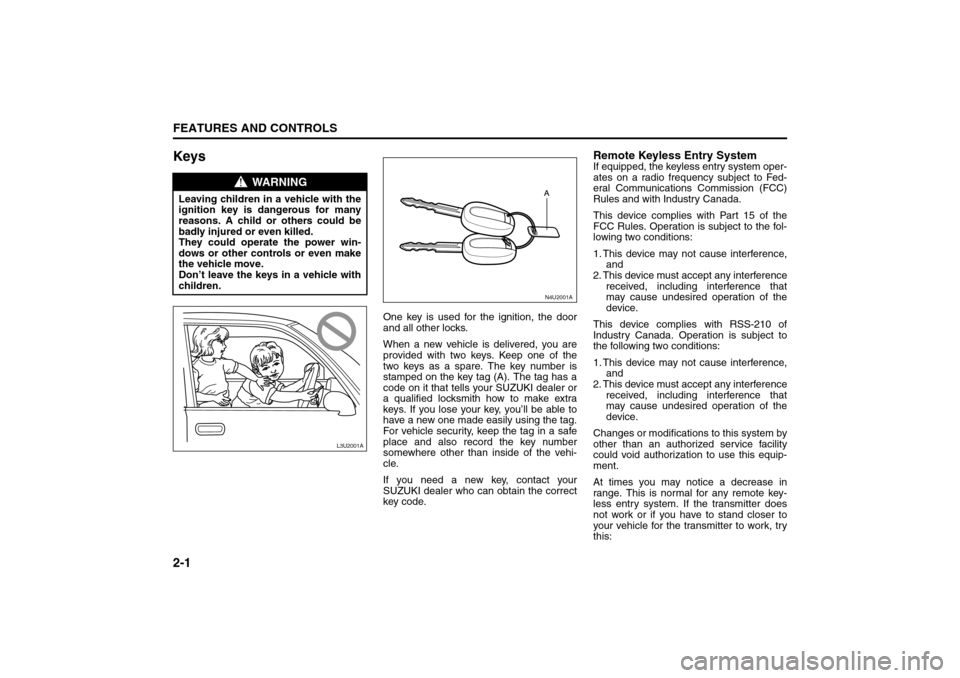
2-1FEATURES AND CONTROLS
85Z14-03E
Keys
One key is used for the ignition, the door
and all other locks.
When a new vehicle is delivered, you are
provided with two keys. Keep one of the
two keys as a spare. The key number is
stamped on the key tag (A). The tag has a
code on it that tells your SUZUKI dealer or
a qualified locksmith how to make extra
keys. If you lose your key, you’ll be able to
have a new one made easily using the tag.
For vehicle security, keep the tag in a safe
place and also record the key number
somewhere other than inside of the vehi-
cle.
If you need a new key, contact your
SUZUKI dealer who can obtain the correct
key code.
Remote Keyless Entry SystemIf equipped, the keyless entry system oper-
ates on a radio frequency subject to Fed-
eral Communications Commission (FCC)
Rules and with Industry Canada.
This device complies with Part 15 of the
FCC Rules. Operation is subject to the fol-
lowing two conditions:
1. This device may not cause interference,
and
2. This device must accept any interference
received, including interference that
may cause undesired operation of the
device.
This device complies with RSS-210 of
Industry Canada. Operation is subject to
the following two conditions:
1. This device may not cause interference,
and
2. This device must accept any interference
received, including interference that
may cause undesired operation of the
device.
Changes or modifications to this system by
other than an authorized service facility
could void authorization to use this equip-
ment.
At times you may notice a decrease in
range. This is normal for any remote key-
less entry system. If the transmitter does
not work or if you have to stand closer to
your vehicle for the transmitter to work, try
this:
WARNING
Leaving children in a vehicle with the
ignition key is dangerous for many
reasons. A child or others could be
badly injured or even killed.
They could operate the power win-
dows or other controls or even make
the vehicle move.
Don’t leave the keys in a vehicle with
children.
L3U2001A
N4U2001A
Keys:
Page 50 of 226
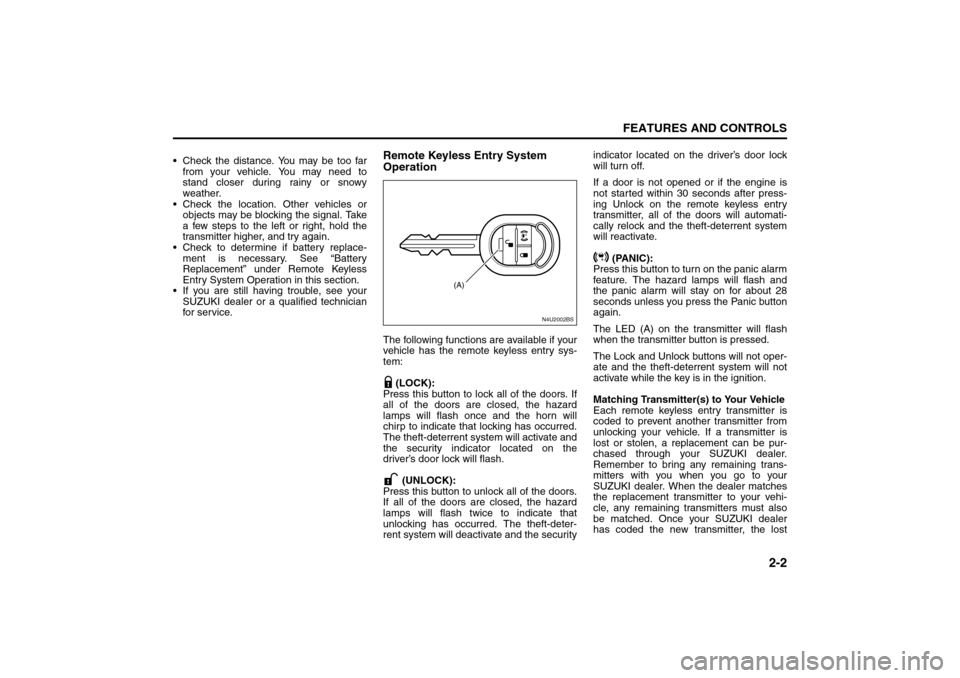
2-2
FEATURES AND CONTROLS
85Z14-03E
Check the distance. You may be too far
from your vehicle. You may need to
stand closer during rainy or snowy
weather.
Check the location. Other vehicles or
objects may be blocking the signal. Take
a few steps to the left or right, hold the
transmitter higher, and try again.
Check to determine if battery replace-
ment is necessary. See “Battery
Replacement” under Remote Keyless
Entry System Operation in this section.
If you are still having trouble, see your
SUZUKI dealer or a qualified technician
for ser vice.
Remote Keyless Entry System
OperationThe following functions are available if your
vehicle has the remote keyless entry sys-
tem:
(LOCK):
Press this button to lock all of the doors. If
all of the doors are closed, the hazard
lamps will flash once and the horn will
chirp to indicate that locking has occurred.
The theft-deterrent system will activate and
the security indicator located on the
driver’s door lock will flash.
(UNLOCK):
Press this button to unlock all of the doors.
If all of the doors are closed, the hazard
lamps will flash twice to indicate that
unlocking has occurred. The theft-deter-
rent system will deactivate and the securityindicator located on the driver’s door lock
will turn off.
If a door is not opened or if the engine is
not started within 30 seconds after press-
ing Unlock on the remote keyless entry
transmitter, all of the doors will automati-
cally relock and the theft-deterrent system
will reactivate.
(PANIC):
Press this button to turn on the panic alarm
feature. The hazard lamps will flash and
the panic alarm will stay on for about 28
seconds unless you press the Panic button
again.
The LED (A) on the transmitter will flash
when the transmitter button is pressed.
The Lock and Unlock buttons will not oper-
ate and the theft-deterrent system will not
activate while the key is in the ignition.
Matching Transmitter(s) to Your Vehicle
Each remote keyless entry transmitter is
coded to prevent another transmitter from
unlocking your vehicle. If a transmitter is
lost or stolen, a replacement can be pur-
chased through your SUZUKI dealer.
Remember to bring any remaining trans-
mitters with you when you go to your
SUZUKI dealer. When the dealer matches
the replacement transmitter to your vehi-
cle, any remaining transmitters must also
be matched. Once your SUZUKI dealer
has coded the new transmitter, the lost
N4U2002BS
(A)
Keys:
Page 53 of 226
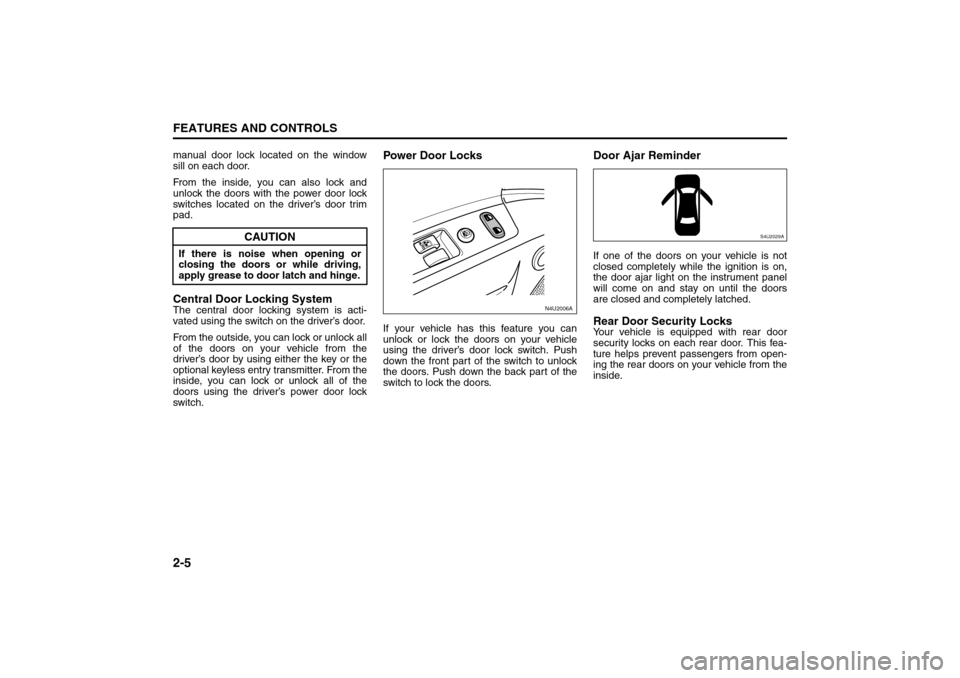
2-5FEATURES AND CONTROLS
85Z14-03E
manual door lock located on the window
sill on each door.
From the inside, you can also lock and
unlock the doors with the power door lock
switches located on the driver’s door trim
pad.Central Door Locking SystemThe central door locking system is acti-
vated using the switch on the driver’s door.
From the outside, you can lock or unlock all
of the doors on your vehicle from the
driver’s door by using either the key or the
optional keyless entry transmitter. From the
inside, you can lock or unlock all of the
doors using the driver’s power door lock
switch.
Power Door LocksIf your vehicle has this feature you can
unlock or lock the doors on your vehicle
using the driver’s door lock switch. Push
down the front part of the switch to unlock
the doors. Push down the back part of the
switch to lock the doors.
Door Ajar ReminderIf one of the doors on your vehicle is not
closed completely while the ignition is on,
the door ajar light on the instrument panel
will come on and stay on until the doors
are closed and completely latched.Rear Door Security LocksYour vehicle is equipped with rear door
security locks on each rear door. This fea-
ture helps prevent passengers from open-
ing the rear doors on your vehicle from the
inside.
CAUTION
If there is noise when opening or
closing the doors or while driving,
apply grease to door latch and hinge.
N4U2006A
S4U2029A
Doors and Locks:
Page 55 of 226
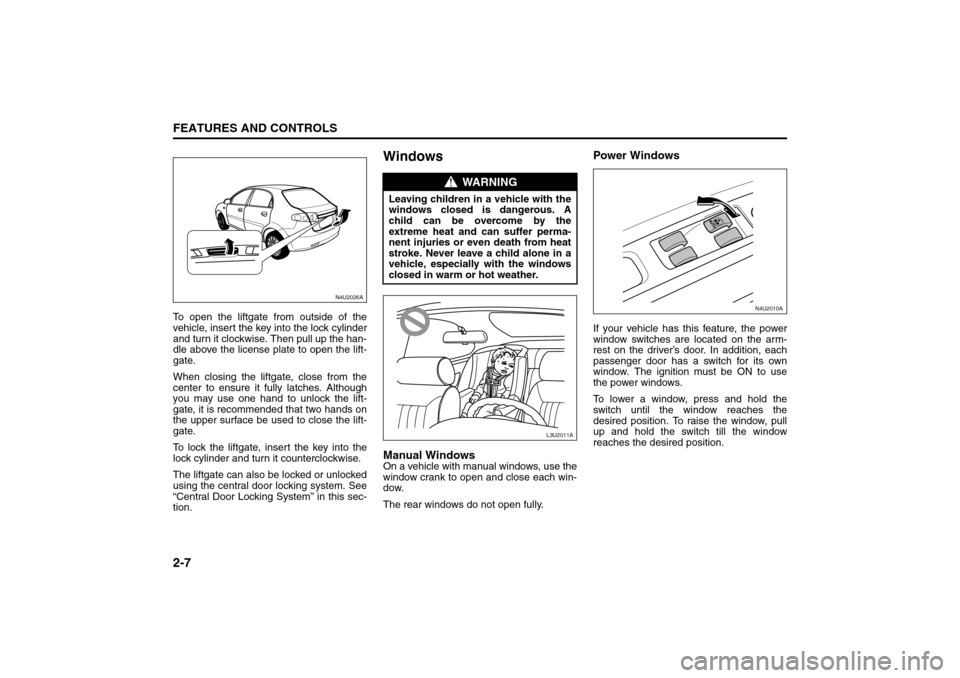
2-7FEATURES AND CONTROLS
85Z14-03E
To open the liftgate from outside of the
vehicle, insert the key into the lock cylinder
and turn it clockwise. Then pull up the han-
dle above the license plate to open the lift-
gate.
When closing the liftgate, close from the
center to ensure it fully latches. Although
you may use one hand to unlock the lift-
gate, it is recommended that two hands on
the upper surface be used to close the lift-
gate.
To lock the liftgate, insert the key into the
lock cylinder and turn it counterclockwise.
The liftgate can also be locked or unlocked
using the central door locking system. See
“Central Door Locking System” in this sec-
tion.
WindowsManual WindowsOn a vehicle with manual windows, use the
window crank to open and close each win-
dow.
The rear windows do not open fully.
Power WindowsIf your vehicle has this feature, the power
window switches are located on the arm-
rest on the driver’s door. In addition, each
passenger door has a switch for its own
window. The ignition must be ON to use
the power windows.
To lower a window, press and hold the
switch until the window reaches the
desired position. To raise the window, pull
up and hold the switch till the window
reaches the desired position.
N4U2026A
WARNING
Leaving children in a vehicle with the
windows closed is dangerous. A
child can be overcome by the
extreme heat and can suffer perma-
nent injuries or even death from heat
stroke. Never leave a child alone in a
vehicle, especially with the windows
closed in warm or hot weather.
L3U2011A
N4U2010A
Doors and Locks:
Windows:
Page 56 of 226
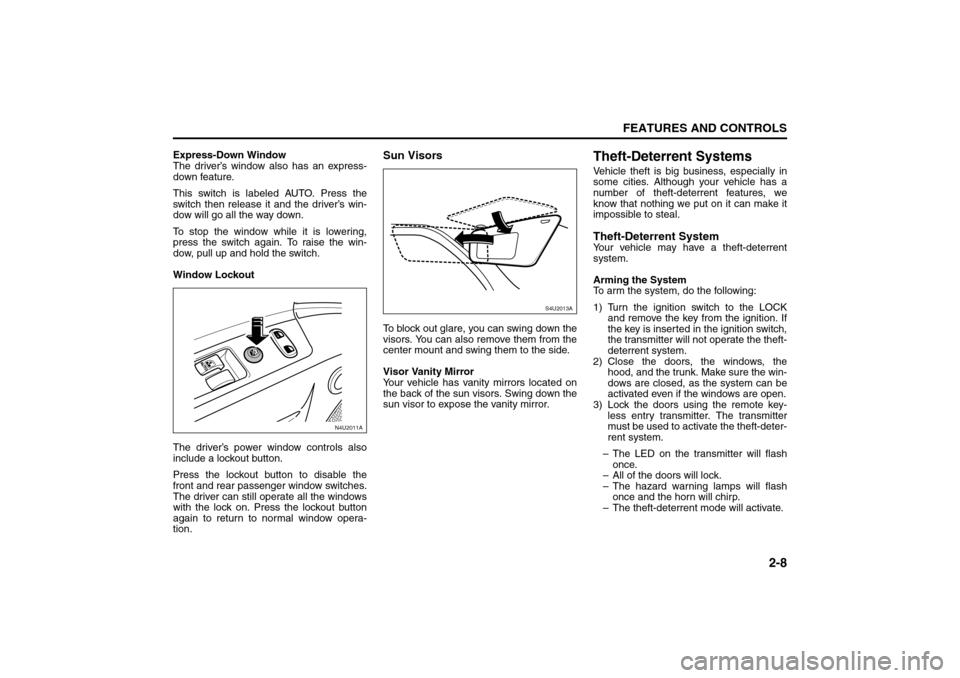
2-8
FEATURES AND CONTROLS
85Z14-03E
Express-Down Window
The driver’s window also has an express-
down feature.
This switch is labeled AUTO. Press the
switch then release it and the driver’s win-
dow will go all the way down.
To stop the window while it is lowering,
press the switch again. To raise the win-
dow, pull up and hold the switch.
Window Lockout
The driver’s power window controls also
include a lockout button.
Press the lockout button to disable the
front and rear passenger window switches.
The driver can still operate all the windows
with the lock on. Press the lockout button
again to return to normal window opera-
tion.
Sun VisorsTo block out glare, you can swing down the
visors. You can also remove them from the
center mount and swing them to the side.
Visor Vanity Mirror
Your vehicle has vanity mirrors located on
the back of the sun visors. Swing down the
sun visor to expose the vanity mirror.
Theft-Deterrent SystemsVehicle theft is big business, especially in
some cities. Although your vehicle has a
number of theft-deterrent features, we
know that nothing we put on it can make it
impossible to steal.Theft-Deterrent SystemYour vehicle may have a theft-deterrent
system.
Arming the System
To arm the system, do the following:
1) Turn the ignition switch to the LOCK
and remove the key from the ignition. If
the key is inserted in the ignition switch,
the transmitter will not operate the theft-
deterrent system.
2) Close the doors, the windows, the
hood, and the trunk. Make sure the win-
dows are closed, as the system can be
activated even if the windows are open.
3) Lock the doors using the remote key-
less entry transmitter. The transmitter
must be used to activate the theft-deter-
rent system.
– The LED on the transmitter will flash
once.
– All of the doors will lock.
– The hazard warning lamps will flash
once and the horn will chirp.
– The theft-deterrent mode will activate.
N4U2011A
S4U2013A
Windows:
Theft-Deterrent Systems:
Page 59 of 226
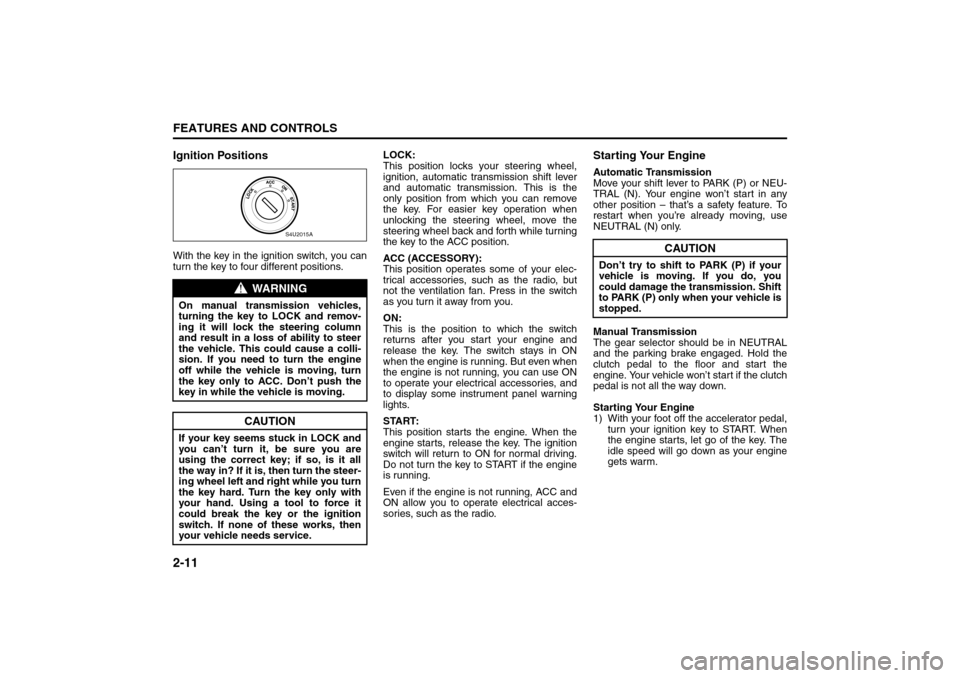
2-11FEATURES AND CONTROLS
85Z14-03E
Ignition PositionsWith the key in the ignition switch, you can
turn the key to four different positions.LOCK:
This position locks your steering wheel,
ignition, automatic transmission shift lever
and automatic transmission. This is the
only position from which you can remove
the key. For easier key operation when
unlocking the steering wheel, move the
steering wheel back and forth while turning
the key to the ACC position.
ACC (ACCESSORY):
This position operates some of your elec-
trical accessories, such as the radio, but
not the ventilation fan. Press in the switch
as you turn it away from you.
ON:
This is the position to which the switch
returns after you start your engine and
release the key. The switch stays in ON
when the engine is running. But even when
the engine is not running, you can use ON
to operate your electrical accessories, and
to display some instrument panel warning
lights.
START:
This position starts the engine. When the
engine starts, release the key. The ignition
switch will return to ON for normal driving.
Do not turn the key to START if the engine
is running.
Even if the engine is not running, ACC and
ON allow you to operate electrical acces-
sories, such as the radio.
Starting Your EngineAutomatic Transmission
Move your shift lever to PARK (P) or NEU-
TRAL (N). Your engine won’t start in any
other position – that’s a safety feature. To
restart when you’re already moving, use
NEUTRAL (N) only.
Manual Transmission
The gear selector should be in NEUTRAL
and the parking brake engaged. Hold the
clutch pedal to the floor and start the
engine. Your vehicle won’t start if the clutch
pedal is not all the way down.
Starting Your Engine
1) With your foot off the accelerator pedal,
turn your ignition key to START. When
the engine starts, let go of the key. The
idle speed will go down as your engine
gets warm.
WARNING
On manual transmission vehicles,
turning the key to LOCK and remov-
ing it will lock the steering column
and result in a loss of ability to steer
the vehicle. This could cause a colli-
sion. If you need to turn the engine
off while the vehicle is moving, turn
the key only to ACC. Don’t push the
key in while the vehicle is moving.
CAUTION
If your key seems stuck in LOCK and
you can’t turn it, be sure you are
using the correct key; if so, is it all
the way in? If it is, then turn the steer-
ing wheel left and right while you turn
the key hard. Turn the key only with
your hand. Using a tool to force it
could break the key or the ignition
switch. If none of these works, then
your vehicle needs service.
S4U2015A
CAUTION
Don’t try to shift to PARK (P) if your
vehicle is moving. If you do, you
could damage the transmission. Shift
to PARK (P) only when your vehicle is
stopped.
Starting and Operating Your Vehicle:
Page 60 of 226
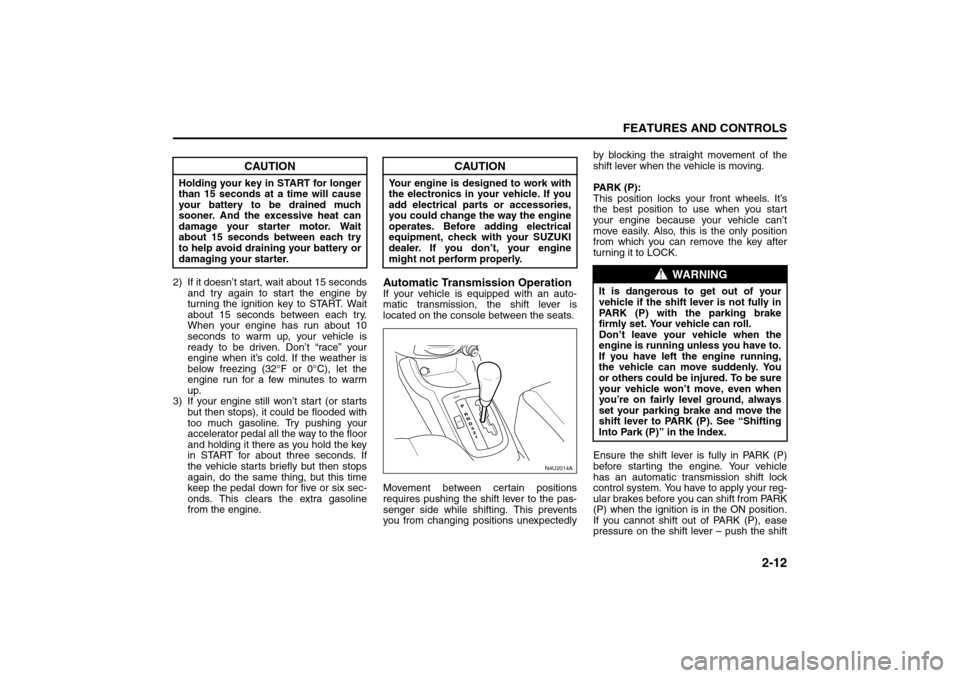
2-12
FEATURES AND CONTROLS
85Z14-03E
2) If it doesn’t start, wait about 15 seconds
and try again to start the engine by
turning the ignition key to START. Wait
about 15 seconds between each try.
When your engine has run about 10
seconds to warm up, your vehicle is
ready to be driven. Don’t “race” your
engine when it’s cold. If the weather is
below freezing (32°F or 0°C), let the
engine run for a few minutes to warm
up.
3) If your engine still won’t start (or starts
but then stops), it could be flooded with
too much gasoline. Try pushing your
accelerator pedal all the way to the floor
and holding it there as you hold the key
in START for about three seconds. If
the vehicle starts briefly but then stops
again, do the same thing, but this time
keep the pedal down for five or six sec-
onds. This clears the extra gasoline
from the engine.
Automatic Transmission OperationIf your vehicle is equipped with an auto-
matic transmission, the shift lever is
located on the console between the seats.
Movement between certain positions
requires pushing the shift lever to the pas-
senger side while shifting. This prevents
you from changing positions unexpectedlyby blocking the straight movement of the
shift lever when the vehicle is moving.
PARK (P):
This position locks your front wheels. It’s
the best position to use when you start
your engine because your vehicle can’t
move easily. Also, this is the only position
from which you can remove the key after
turning it to LOCK.
Ensure the shift lever is fully in PARK (P)
before starting the engine. Your vehicle
has an automatic transmission shift lock
control system. You have to apply your reg-
ular brakes before you can shift from PARK
(P) when the ignition is in the ON position.
If you cannot shift out of PARK (P), ease
pressure on the shift lever – push the shift
CAUTION
Holding your key in START for longer
than 15 seconds at a time will cause
your battery to be drained much
sooner. And the excessive heat can
damage your starter motor. Wait
about 15 seconds between each try
to help avoid draining your battery or
damaging your starter.
CAUTION
Your engine is designed to work with
the electronics in your vehicle. If you
add electrical parts or accessories,
you could change the way the engine
operates. Before adding electrical
equipment, check with your SUZUKI
dealer. If you don’t, your engine
might not perform properly.
N4U2014A
H
O
L
D
WARNING
It is dangerous to get out of your
vehicle if the shift lever is not fully in
PARK (P) with the parking brake
firmly set. Your vehicle can roll.
Don’t leave your vehicle when the
engine is running unless you have to.
If you have left the engine running,
the vehicle can move suddenly. You
or others could be injured. To be sure
your vehicle won’t move, even when
you’re on fairly level ground, always
set your parking brake and move the
shift lever to PARK (P). See “Shifting
Into Park (P)” in the Index.
Starting and Operating Your Vehicle: